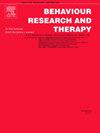日常生活中社交焦虑的注意机制:负性自我关注对事件后加工的独特影响
IF 4.5
2区 心理学
Q1 PSYCHOLOGY, CLINICAL
引用次数: 0
摘要
社交焦虑障碍(SAD)的特点是有偏见的注意模式,理论上在维持症状中起关键作用。SAD与外部导向的注意偏见(即对社会评价性威胁的注意偏见)和内部导向的注意偏见(即对充满焦虑的想法和感觉的注意偏见)有关,两者都可能增加事件后加工(PEP)的倾向,这是一种对过去社会事件消极方面的反思形式。然而,先前关于SAD患者注意偏差的研究主要是在实验室环境中进行的,没有回答关于最强烈表征和维持社交焦虑的注意和认知的自然模式的问题。本研究应用生态瞬间评估(EMA)来研究现实世界社交互动中的注意偏差及其对高(n = 108)和低(n = 94)社交焦虑水平成人随后PEP的影响。在一周内,参与者每天三次报告他们的注意取向(即内部与外部),他们的注意焦点的效价(即消极与积极),以及他们在重大社会事件后的PEP程度。结果显示,高(相对低)水平的社交焦虑与社交互动中相对更多的内部导向和负价值注意力相关,这反过来预测了随后PEP的增加。研究结果强调了消极自我关注和反刍思维作为社交焦虑维持因素的重要性,并表明针对这些机制的干预措施可能在未来的研究中显示出希望。本文章由计算机程序翻译,如有差异,请以英文原文为准。
Attention mechanisms of social anxiety in daily life: Unique effects of negative self-focused attention on post-event processing
Social anxiety disorder (SAD) is characterized by biased patterns of attention that are theorized to play a key role in maintaining symptoms. SAD has been linked to externally oriented attentional biases (i.e., towards social-evaluative threats) and internally oriented attentional biases (i.e., towards anxiety-laden thoughts and sensations), both of which might increase proneness for post-event processing (PEP), a form of rumination about the negative aspects of past social events. However, prior research examining attentional biases in SAD has primarily been conducted in laboratory settings, leaving unanswered questions about the naturalistic patterns of attention and cognition that most strongly characterize and maintain social anxiety. The present study applied ecological momentary assessment (EMA) to examine attentional biases during real-world social interactions and their effects on subsequent PEP in a sample of adults with high (n = 108) and low (n = 94) levels of social anxiety. Three times per day for one week, participants reported their attention orientation (i.e., internal versus external), the valence of their attentional foci (i.e., negative versus positive), and their degree of PEP following salient social events. Results revealed that high (vs. low) levels of social anxiety were associated with relatively more internally oriented and negatively valenced attention during social interactions, which in turn predicted increases in subsequent PEP. Findings highlight the salience of negative self-focused attention and ruminative thinking as maintenance factors in social anxiety, and suggest that interventions targeting these mechanisms could show promise in future research.
求助全文
通过发布文献求助,成功后即可免费获取论文全文。
去求助
来源期刊

Behaviour Research and Therapy
PSYCHOLOGY, CLINICAL-
CiteScore
7.50
自引率
7.30%
发文量
148
期刊介绍:
The major focus of Behaviour Research and Therapy is an experimental psychopathology approach to understanding emotional and behavioral disorders and their prevention and treatment, using cognitive, behavioral, and psychophysiological (including neural) methods and models. This includes laboratory-based experimental studies with healthy, at risk and subclinical individuals that inform clinical application as well as studies with clinically severe samples. The following types of submissions are encouraged: theoretical reviews of mechanisms that contribute to psychopathology and that offer new treatment targets; tests of novel, mechanistically focused psychological interventions, especially ones that include theory-driven or experimentally-derived predictors, moderators and mediators; and innovations in dissemination and implementation of evidence-based practices into clinical practice in psychology and associated fields, especially those that target underlying mechanisms or focus on novel approaches to treatment delivery. In addition to traditional psychological disorders, the scope of the journal includes behavioural medicine (e.g., chronic pain). The journal will not consider manuscripts dealing primarily with measurement, psychometric analyses, and personality assessment.
 求助内容:
求助内容: 应助结果提醒方式:
应助结果提醒方式:


